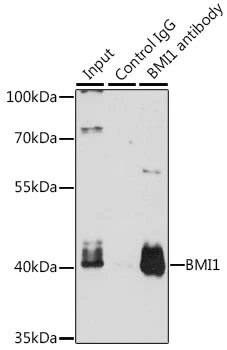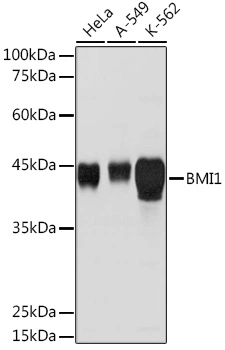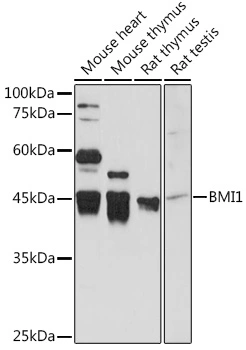
IP analysis of K-562 cell lysate using GTX32472 Bmi1 antibody. Antibody amount : 3microg / 200microg lysate Dilution : 1:1000
Bmi1 antibody
GTX32472
ApplicationsImmunoPrecipitation, Western Blot
Product group Antibodies
TargetBMI1
Overview
- SupplierGeneTex
- Product NameBmi1 antibody
- Delivery Days Customer9
- Application Supplier NoteWB: 1:500 - 1:2000. IP: 1:50 - 1:100. *Optimal dilutions/concentrations should be determined by the researcher.Not tested in other applications.
- ApplicationsImmunoPrecipitation, Western Blot
- CertificationResearch Use Only
- ClonalityPolyclonal
- ConjugateUnconjugated
- Gene ID648
- Target nameBMI1
- Target descriptionBMI1 proto-oncogene, polycomb ring finger
- Target synonymsFLVI2/BMI1, PCGF4, RNF51, flvi-2/bmi-1, polycomb complex protein BMI-1, B lymphoma Mo-MLV insertion region 1 homolog, BMI1 polycomb ring finger oncogene, BMI1 polycomb ring finger proto-oncogene, murine leukemia viral (bmi-1) oncogene homolog, polycomb group RING finger protein 4, polycomb group protein Bmi1, ring finger protein 51
- HostRabbit
- IsotypeIgG
- Protein IDP35226
- Protein NamePolycomb complex protein BMI-1
- Scientific DescriptionThis gene encodes a ring finger protein that is major component of the polycomb group complex 1 (PRC1). This complex functions through chromatin remodeling as an essential epigenetic repressor of multiple regulatory genes involved in embryonic development and self-renewal in somatic stem cells. This protein also plays a central role in DNA damage repair. This gene is an oncogene and aberrant expression is associated with numerous cancers and is associated with resistance to certain chemotherapies. A pseudogene of this gene is found on chromosome X. Read-through transcription also exists between this gene and the upstream COMM domain containing 3 (COMMD3) gene. [provided by RefSeq, Sep 2015]
- Storage Instruction-20°C or -80°C,2°C to 8°C
- UNSPSC12352203





![ELISA analysis of antigen using GTX60516 Bmi1 antibody [3E3]. Black : Control antigen 100ng Purple : Antigen 10ng Blue : Antigen 50ng Red : Antigen 100ng](https://www.genetex.com/upload/website/prouct_img/normal/GTX60516/GTX60516_20170912_ELISA_w_23061123_846.webp)




